by Paul Braterman
20th-century creationism and racism

Henry Morris, founding father of modern Young Earth creationism, wrote in 1977 that the Hamitic races (including red, yellow, and black) were destined by their nature to be servants to the descendants of Shem and Japheth. Noah was inspired when he prophesied this (Genesis 9:25-27) [1]. The descendants of Shem are characterised by an inherited religious zeal, those of Japheth by mental acumen, while those of Ham are limited by the “peculiarly concrete and materialistic thought-structure inherent in Hamitic peoples,” which even affects their language structures. These innate differences explain the success of the European and Middle Eastern empires, as well as African servitude.
 All this is spelt out in Morris’s 1977 book, The Beginning of the World, most recently reprinted in 2005 (in Morris’s lifetime, and presumably with his approval), and available from Amazon as a paperback or on Kindle.
All this is spelt out in Morris’s 1977 book, The Beginning of the World, most recently reprinted in 2005 (in Morris’s lifetime, and presumably with his approval), and available from Amazon as a paperback or on Kindle.
Morris is no fringe figure. On the contrary, he, more than any other individual, was responsible for the 20th-century invention of Young Earth “creation science”. He was co-author of The Genesis Flood, which regards Noah’s flood as responsible for sediments worldwide, and founded the Institute of Creation Research (of which Answers in Genesis is a later offshoot) in 1972, serving as its President, and then President Emeritus, until his death in 2006.
Nor was this a personal aberration. As we shall see, he was heir to a strong tradition of creationist racism, of which he never managed to rid himself.
Strong accusations require strong evidence. I have therefore included as an Appendix some relevant passages from The Beginning of the World, quoting at length to avoid any risk of misrepresentation.
 Very similar views to those of Morris were expressed by the esteemed physiologist Arthur Custance (Noah’s Three Sons, 1975, published by the mainstream Christian publisher Zondervan, now part of Harper Collins). Custance and Morris certainly knew about each other as intellectual opponents, Morris favouring simple six-day creationism, while Custance championed the “Gap Theory”, according to which geological time is concealed within the opening three verses of Genesis. However, Morris clearly got there first, since he had published similar material in 1972 (The Remarkable Birth of Planet Earth), while The Beginning of the Earth was an update of a work first published in 1965.
Very similar views to those of Morris were expressed by the esteemed physiologist Arthur Custance (Noah’s Three Sons, 1975, published by the mainstream Christian publisher Zondervan, now part of Harper Collins). Custance and Morris certainly knew about each other as intellectual opponents, Morris favouring simple six-day creationism, while Custance championed the “Gap Theory”, according to which geological time is concealed within the opening three verses of Genesis. However, Morris clearly got there first, since he had published similar material in 1972 (The Remarkable Birth of Planet Earth), while The Beginning of the Earth was an update of a work first published in 1965.
Creationism, Adventism, and institutional racism
Note: Morris and other authors whom I cite used the word “Negro”, as I do for consistency when referring to their work. This word, unlike its toxic cousin, was not historically regarded as offensive, although it now sometimes is. For instance, the University of Chicago’s estimable Journal of African-American History called itself the Journal of Negro History until 2002.
While Morris was the most effective 20th-century exponent of biblical creationism, his theories derived largely from those of the Seventh-day Adventist George McCready Price, whose ideas derived in turn from those of Ellen G. White, founder-prophetess of Adventism. White had spoken of the evils of crossbreeding. Price ascribed the variety of human races to the dispersal after Babel, the deleterious effects of interbreeding, and environmental effects, which had given the Negro his dark skin, while, Price said, “his mind became a blank.”[2]

Biblical literalism and creationism were used to support racial discrimination and bans on interracial marriage until quite recently. In South Africa, biblical literalism was used to justify apartheid, on the grounds that when God dispersed the various nations at Babel, He intended them to remain separate. The Dutch Reformed Church in South Africa supported apartheid until 1986. The Southern Baptist Convention, now the largest Protestant denomination in the United States with 15 million members, was formed, in 1845, specifically in defence of slavery, and did not apologise for this until 1995, when it adopted a resolution on racial reconciliation, and committed itself to the removal of racism. Bob Jones University, rigidly creationist and biblical literalist, and the publisher of numerous texts for creationist homeschooling, refused admission to black students until 1971, and denied admission to applicants engaged in an interracial marriage or known to advocate interracial marriage or dating until 2000.
What about Darwin?
How often have we heard the accusation that evolutionary thinking is responsible for racism, as if Darwin had invented the concept. See for example this quotation from Henry Morris himself, on the Institute for Creation Research website, in 1993:
But what about the origin of races? One searches the Bible in vain for this information, for neither the word nor the concept of “race” appears in the Bible at all! There is no such thing as a race—except the human race! … “Race” is strictly an evolutionary concept, used by Darwin, Huxley, Haeckel, and the other 19th-century evolutionists to rationalize their white racism.
That’s a lie. Morris is denying his own earlier blatant racism, which I described my opening paragraph (the word “race” occurs, without apology, in the chapter title I cited and repeatedly throughout the text). Moreover, I can hardly believe that Morris was completely ignorant of the strength of racism among strongly anti-Darwin churches and colleges, or of the long history of racism and the ways in which pre-evolutionary science had been used to justify it.
Early studies of race
It is, I hope, common knowledge by now that the traditional classification of races corresponds only poorly to genetic reality, that the boundaries between races are fuzzy, arbitrary, and based on minor and quite recent differences, that the variation within a race (however defined) is far greater than the differences between races, and that sub-Saharan Africans, traditionally classified as a single race, are in reality more genetically diverse than the rest of humanity put together. Conversation about the concept of race is made enormously difficult by the damage done its name, but I hope this can be set aside in the present discussion.
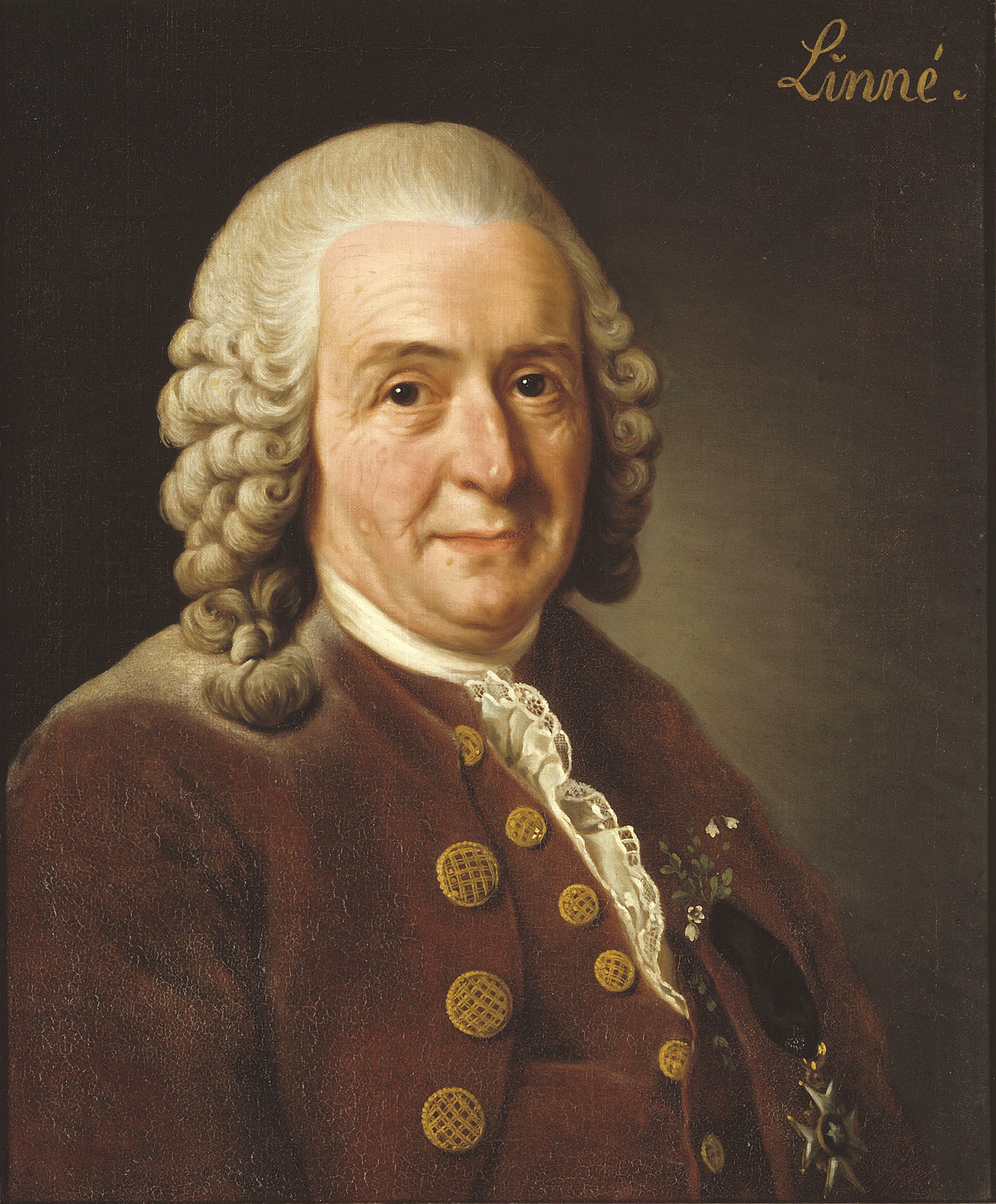
The idea of racial stereotypes goes back at least as far as Linnaeus’ Systema naturae (1735 – 1768), in which he contrasts Europaeus, active and smart, with Afer, crafty, slow, and foolish. Such views were widespread. David Hume, in 1742, wrote that he was “apt to suspect” on the basis of history that Negroes were inferior to whites. Scientific study can be traced to Johann Friedrich Blumenbach, who in the 1790s classified humans on the basis of skull shape as Caucasian (Blumenbach popularised this term, still in common use), Mongolian, Malayan including Southeast Asian and Pacific Islanders, Ethiopian or sub-Saharan African, and American. Very presciently, he noted that variation among Africans was as great as in the rest of humankind, and wrote that Africans had shown themselves capable of the highest levels of attainment. Georges Cuvier, the outstanding naturalist of the early 19th-century, also compared skulls, and distinguished between Caucasian, Mongolian, and Ethiopian, all descended eventually from Adam and Eve. Cuvier made enormous advances in comparative anatomy, based on his understanding of the relationship between form and function, and argued against the then new-fangled idea of evolution on the grounds that since each species was well-adapted to its niche, with parts that worked well together, change would be impossible. I’m reminded here of current arguments against evolution, on grounds of irreducible complexity.
Stereotyping of non-Whites sharpened throughout the nineteenth century. One obvious reason, in the US, was the need to justify slavery. Another, operating more strongly in England, was, according to the historian of ideas Kenan Malik, the emerging class structure of capitalism, and the obvious desirability for the upper classes of thinking that their position was the result of intrinsic merit.
The biblical literalist’s dilemma
Faced with the variety of humankind, and the Genesis account of the Flood, the biblical literalist has two options. The more usual one, and as we have seen the one adopted by Morris, is to regard the different branches of humanity as descended from the three sons of Noah. Since Semitic and Japhethic branches are generally identified as Middle Eastern and European, the rest of humanity is then presumed (as in Morris’s discussion) to descend from Ham. This despite the fact that in Genesis the listed descendants of Ham, just as much as those of Shem, are all Middle Eastern or North African. So here, as in other matters, self-proclaimed biblical literalists are recklessly projecting their own imaginings on the Bible.
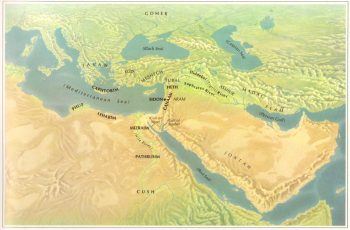
Separate origin theories and 19th-century Flood Geology
The other, even more objectionable, option is to deny that the coloured races (to use an old-fashioned expression) were descended from Adam in the first place. In this version of events, Negroes were a separate creation, and therefore not fully human. This kind of belief regards racial segregation as natural, and mixed marriages as perversion. In some versions, Negroes were created before Adam in order to serve his descendants, while in others, inferior races (Negroes, Chinese, and, some more recently say, Jews) are the offspring of Eve and the Serpent.
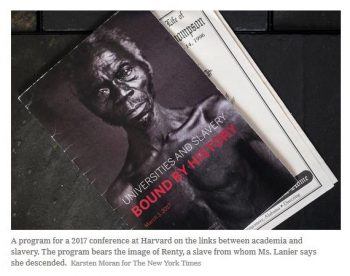 Separate origin theory (polygenism) has a long history and was at one time considered intellectually respectable. The eminent naturalist Louis Agassiz, who discovered the Ice Ages, thought that Whites and Blacks were separate creations, although he believed they should be equal under the law. He commissioned photographs of slaves (see on right) for his anthropological studies, and last week these became the subject of an ownership lawsuit between Harvard University and one of the slaves’ descendants. The creationist Alexander Winchell, Professor in turn at Vanderbilt, the University of Michigan, and the University of Syracuse, argued as late as 1878, in Adamites and Preadamites, that humans existed before Adam, and maintained that this belief was consistent with Scripture.
Separate origin theory (polygenism) has a long history and was at one time considered intellectually respectable. The eminent naturalist Louis Agassiz, who discovered the Ice Ages, thought that Whites and Blacks were separate creations, although he believed they should be equal under the law. He commissioned photographs of slaves (see on right) for his anthropological studies, and last week these became the subject of an ownership lawsuit between Harvard University and one of the slaves’ descendants. The creationist Alexander Winchell, Professor in turn at Vanderbilt, the University of Michigan, and the University of Syracuse, argued as late as 1878, in Adamites and Preadamites, that humans existed before Adam, and maintained that this belief was consistent with Scripture.
However, separate origin theory was soon used, especially in the run-up to the American Civil War, to justify racism, slavery, and segregation. In the 1840s, Samuel George Morton, for a while Professor of Anatomy at Pennsylvania Medical College, and his collaborator George Gliddon (for a while US Vice-Consul in Alexandria), argued for separate creation on biblical grounds. From examining mummies, they had correctly concluded that African and Middle Eastern peoples were in existence three thousand years ago much as they are today. But this was only a thousand years after the date that the Bible gives for Noah’s flood. It followed that such diversity could not have arisen in so little time, forcing them to conclude that the black race had a separate origin. Measuring their skulls, they concluded (are you surprised?) that blacks had lower cranial capacity and hence lower mental capacity than whites, among 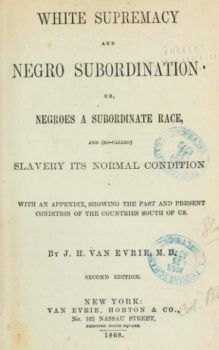 other defects. John Van Evrie in a series of publications between 1848 and 1868 (note the dates), argued that the Negro was a separate creation for whom slavery was the natural state, accused abolitionists of promoting the evil of miscegenation, appealed to discontented and underprivileged whites in the North where he lived, and during the Civil War campaigned for an immediate peace on the Confederacy’s terms. Van Evrie thought that the success of democracy (which was of course for Whites only) depended on Negro subjugation, and his populist writings, as we would now describe them, may have contributed to the 1863 New York Conscription Riots.
other defects. John Van Evrie in a series of publications between 1848 and 1868 (note the dates), argued that the Negro was a separate creation for whom slavery was the natural state, accused abolitionists of promoting the evil of miscegenation, appealed to discontented and underprivileged whites in the North where he lived, and during the Civil War campaigned for an immediate peace on the Confederacy’s terms. Van Evrie thought that the success of democracy (which was of course for Whites only) depended on Negro subjugation, and his populist writings, as we would now describe them, may have contributed to the 1863 New York Conscription Riots.
The clergyman and publisher, Buckner H. Payne (Ariel: or the Ethnological Origin of the Negro, 1867, Reply to the Scientific Geologist and Other Learned Men, in Their Attacks on the Credibility of Account of the Mosaic Account of the Creation and of the Flood, 1876) regarded the Curse of Ham as irrelevant to the issue of slavery, since the Negro was a Preadamite creation without a soul. Miscegenation was the sin that 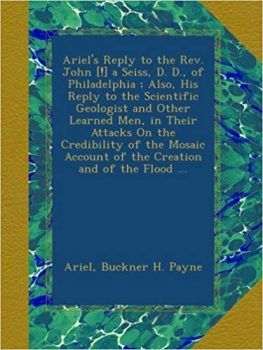 led to the Flood, and (here Payne anticipates modern Young Earth creationism) the mountains were raised to their present height by the convulsions associated with Noah’s Flood, when (Genesis 7:11) the Fountains of the Deep were broken up. Here Payne’s geology anticipates that of Whitcomb and Morris’s The Genesis Flood, already mentioned as the foundational document of 20th-Century Young Earth creationism. Payne earned a brief and rather dismissive obituary in the New York Times on his death in 1883, but other obituaries to Payne described him as the South’s leading logician. Charles Carroll (The Negro as Beast; or, In the Image of God, 1900) cited Winchell (see above), and described Negroes as Preadamite, one of the Genesis “beasts”, but equipped with hands and the power of speech, the better to serve his master, the white man. Carroll acts as a bridge between 19th-century separate origin creationism, and the present-day extremist groups discussed in the next section.
led to the Flood, and (here Payne anticipates modern Young Earth creationism) the mountains were raised to their present height by the convulsions associated with Noah’s Flood, when (Genesis 7:11) the Fountains of the Deep were broken up. Here Payne’s geology anticipates that of Whitcomb and Morris’s The Genesis Flood, already mentioned as the foundational document of 20th-Century Young Earth creationism. Payne earned a brief and rather dismissive obituary in the New York Times on his death in 1883, but other obituaries to Payne described him as the South’s leading logician. Charles Carroll (The Negro as Beast; or, In the Image of God, 1900) cited Winchell (see above), and described Negroes as Preadamite, one of the Genesis “beasts”, but equipped with hands and the power of speech, the better to serve his master, the white man. Carroll acts as a bridge between 19th-century separate origin creationism, and the present-day extremist groups discussed in the next section.
Separate origin creationism and the American Far Right
Separate origin theory persists among White extremist groups in America. According to Alexander Schiffner’s The Origin of the Races; and Pre-Adamic Man (Prophetic Herald, 1968), the yellow races as well as Negroes are beasts created before Adam. Carroll’s ideas also re-emerged in Destiny Publishers’ 1967 In the Image of God, which regards miscegenation as a wicked perversion, the real sin of Cain, and the sin that provoked the Flood. Ham was of part-Negro descent, and the demands of the Civil Rights Movement for racial integration were inspired by Satan.
At this point separate origins theory merges with anti-Semitism and anti-Communism. W. Clyde Odeneal, in Segregation: Sin or Sensible? (Destiny Publishers, 1958), argued that “Segregation is an Anglo-Saxon principle because… The Anglo-Saxon, Celtic and related races are predominantly the Bible-reading, Bible-disseminating peoples of the world”, and condemned racial equality as a Communist notion, promoted by non-Christians. I understand this as a clear reference to Jewish Civil Rights activists. Charles Magne, The Negro and the World Crisis (Kingdom Identity Ministries, 1980), also considered Negroes as apes, created before Adam, and wrote that they were being used by Jews to destroy the White Nordic race. The Christian Identity movement, which has strong historical links to the KKK, is closely related to the British Israelites. Both Identity and the British Israelites regard the Anglo-Celtic race as God’s favoured people, the true descendants of Israel, and maintain that the inferior (i.e. non-White) races were created before Adam. Similar separate origin beliefs are also held by other fringe groups, such as Aryan Nations, which shares a website with the Church of Jesus Christ Christian, and maintains that “The Canaanite Jews [i.e. Jews] are a literal descendent of Satan and the natural enemy of our white Christian race.” Aryan Nations is affiliated with the Aryan Brotherhood, the most powerful White gang in US prisons.
There are a few self-styled ministries (whom I do not intend to publicise) who reprint obscure 19th Century separate origins pamphlets. Destiny Publishers is still in existence, linked to the British Israelite movement, and describing itself on its front page as “devoted to revealing the Book of the People to the People of the Book.” Kingdom Identity Ministries continues to distribute books and cassettes from its website and from its “American Institute of Theology”, and to broadcast. Its homepage shows a serpent with the head of a caricature Jew and, just in case you don’t get the message, a bright yellow body covered in six-pointed stars.
Creationism and Nazism
We can now place Nazi racism in its context. Despite creationist claims, it has nothing to do with evolution science or any other kind of science, but is an extreme form of separate origin mythology. It places great emphasis on the distinct origins of races, together with a mystic belief in race, blood, and soil. Thus Alfred Rosenberg, official Nazi philosopher, taught that God had created Man as separate races, with of course the Aryan race superior to all others, and destined to rule over them. It followed that it was the duty of Aryans to purify their lands by eliminating non-Aryans as cancer is cut from diseased body. Rosenberg powerfully influenced Hitler, who in Mein Kampf wrote that God and nature had created the races as separate, so that miscegenation was a sin against nature and God’s will. Hitler did believe in evolution within a race (microevolution), but regarded the races as separate creations and explicitly rejected the evolution of humans from non-human ancestors. (I could not bring myself to read Rosenberg’s or Hitler’s actual writings, but have relied here and in much of my discussion of creationist racism on Tom McIver’s compilations of creationist writings, Anti-Evolution, and his article “The Protocols of Creationism”, Sceptic Magazine 2(4), 1994, p. 76. For more on Hitler’s views, see e.g. this from the Evolution Institute, of which I am a supporter, and references therein)
Mainstream creationism today
To return to mainstream creationism, I looked up the word “race” on the website of leading creationist organisations. Answers in Genesis, historically an offshoot of the Institute for Creation Research, and probably the leading biblical literalist organisation today, goes out of its way to downplay racial differences. It advances a fantastical family tree for humankind (with the peoples of Japan and Java related to the Ionian Greeks), but does say that Noah’s prophecy referred specifically to the interaction between the ancient Israelites and their Canaanite neighbours. Creation Ministries International says little about Noah’s curse (or prophesy), heavily emphasizes the biological unity of humankind, and explicitly condemns Christian Identity
What, then, of Morris’s own Institute for Creation Research? That, you may remember, is where Morris had written that “race” was an unbiblical concept introduced by evolutionists in order to maintain their belief in white superiority. Did that mean that he had transcended, as well as disavowing, his earlier racism? I doubt it. A search for “Canaan” on the Institute for Creation Research website leads to the study notes for his New Defenders Bible (2006, the last year of his life), which refer to “Ham, with his physical and materialistic bent,” and speak of “Noah’s own insight into the developing characters of his sons and grandsons and, therefore, of their descendants.” [Emphasis added]
As Malik very recently (18 March 2019) put it, “The idea of abstract, essential differences between specially-defined populations is what lies at the heart of racial thinking”. Morris, by this standard, was a racial thinker to the end. He had sanitised his vocabulary, and his self-image, but not his thinking. And if his followers still think, as he did, that Noah’s words refer to anything beyond the ancient Near East, they have cause for soul-searching.
1] KJV, And he said, Cursed be Canaan, as servants of servants shall he be and to his brethren. And he said, Blessed be the Lord God of Shem; and Canaan shall be his servant. God shall enlarge Japheth, and he shall dwell in the tens of Shem; and Canaan shall be his servant.
2] Ronald Numbers, The Creationists p.102.
I thank Tom McIver for helpful correspondence, and for drawing my attention to his catalogue updates, https://www.librarything.com/catalog/tmciver and https://www.librarycat.org/lib/tmciver/search/text/racism. Embedded links to AiG, ICR, and CMI set at no-follow to avoid boosting.
Appendix: extracts from The Beginning of the World
With the deepest hearts of his own sons thus laid bare before him, Noah was moved to make the great prophetic declaration of Genesis 9:25 – 27. To some extent the insight thus revealed into the future was no doubt based on the insights he had into the hearts of his sons… But, more importantly, he spoke in the Spirit, prophesying as the Spirit gave utterance. [p 127]
As he knew the characters of his own sons, he could foresee that their respective descendants would be characterised chiefly by religious zeal (Shem), mental acumen (Japheth) and materialistic drives (Ham).) [p 128]
The prophecy is worldwide in scope and, since Shem and Japheth are covered, all Ham’s descendants must be also. These include all nations which are neither Semitic nor Japhetic. Thus, all of the earth’s “coloured” races, – yellow, red, brown, and black – essentially the Afro-nation group of peoples, including the American Indians – are most likely to be Hamitic in origin and included within the scope of the Canaanitic prophecy, as well as the Egyptians, Sumerians, Hittites, and Phoenicians of antiquity. [p 129]
Truly they have been ‘servants’ of mankind in a most amazing way. Yet the prophecy again has its obverse side. Somehow they have only gone so far and no farther. The Japhethites and Semites have, sooner or later, taken over their territories, and their inventions, and then developed them and utilised them for their own enlargement. Often the Hamites, especially the Negroes, have become actual personal servants or even slaves to the others. Possessed of a racial character concerned mainly with mundane matters, they have eventually been displaced by the intellectual and philosophical acumen of the Japhethites and the religious zeal of the Semites.… Neither Negroes nor any other Hamitic people are intended to be forcibly subjugated on the basis of this Noahic declaration. The prophecy would be inevitably fulfilled because of the innate nature of the three racial stocks, not by virtue of any artificial constraints imposed by man.” [p 130]
Every little Indian or African tribe seems to have developed its own language, by virtue of its own isolation and the peculiarly concrete and materialistic thought-structure inherent in Hamitic peoples. [p. 142. Morris regards all languages other than Indo-European and Semitic as Hamitic]
